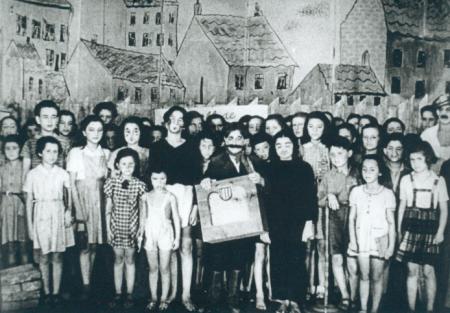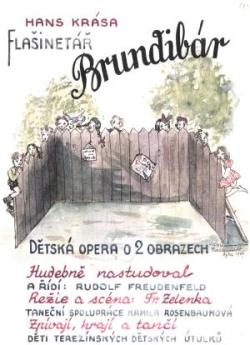The children's opera Brundibár was written by composer Hans Krása and writer Adolf Hoffmeister in 1938 . In mid-1941 a production of it was directed by Rafael Schächter, with several friends, as a fiftieth birthday present for the director of the orphanage at Hagibor. The stage architect František Zelenka constructed a fence with boards on the stage, on which he placed cut-outs of animal figures with holes for the children's faces. There were only two performances of the production in Prague, and they took place in secret, since by that time Jews were already banned from participating in cultural activities. In August 1942 Hans Krása was deported to Terezín, followed by many of the adults and children with whom he had worked.

Photograph of the children's company from the film Theresienstadt. (property of the Jewish Museum in Prague)
Rudolf Freudenfeld-Franěk had brought the piano score with him to the ghetto, and started rehearsals in the attic of the Dresden Barracks. Transports continually intervened in his work, and the children taken away to concentration camps in the east had to be replaced by newly-arriving children. After more than two months of rehearsals, the premiere took place on 23 September 1943 in the Magdeburg Barracks. Brundibár was a huge success, and there were around 55 further performances - around one a week - between then and autumn 1944, when the last transports left Terezín.
In spring 1944 the Terezín ghetto was preparing for a visit from an International Red Cross committee, which was meant to assess its function as a model
ghetto that the Führer had given to the Jews.
Brundibár was chosen as the production that would be put on for the committee. The production was moved to a large sports hall outside the ghetto, and Zelenka, who created a set similar to the one he had made in Prague, was given the materials to improve the set and costumes. This beautification of Brundibár had to be managed overnight. The closing scenes of Brundibár were then filmed in summer 1944 for the propaganda film Theresienstadt (better known under the title The Führer Has Given the Jews a Town).

Opera poster, Terezín Memorial archive.
The plot of the opera
Aninka and Pepíček's mother is ill and needs milk in order to get better, but the children have no money. A way of earning it occurs to them when they see the organ-grinder Brundibár earning money in the market. However, Brundibár is evil, and shouts down the children. During the night, the animals from the poster come to help the despairing children, and the next day they help the children to sing louder than the organ-grinder. The children receive their money, but the scoundrel Brundibár takes their earnings from them. In the end the children find him and are given back what belongs to them
The closing lines as written by Adolf Hoffmeister are as follows: He who loves his mummy and daddy and our native land is our friend and can play with us.
For the performance of the opera in the Terezín ghetto, Emil Saudek changed the end to He who loves justice and will stand by it and fears nothing...
The finale became something of a Terezín anthem. The actors and audience knew all too well what, together with the innocent children's struggle against Brundibár, was meant by these words.
-
See also:
-
Our transport was called 'The Whole Kehillah'
. An interview with Tommy Karas, who took part in the opera. (In Czech) -
Brundibár in Porto. Article in Roš chodeš 04/2001. (In Czech)
-
Brundibár conquers the world. Article in Roš chodeš 04/1999. (In Czech)
-
Literature:
-
Šormová, Eva. Divadlo v Terezíně 1941 - 1945 (Theatre in Terezín 1941 - 1945). Památník Terezín a Severočeské nakladatelství Ústí nad Labem, 1973, p. 72-74.
-
Freundfeld-Franěk, Rudolf. Terezínská škola (The Terezín School). Praha: Svaz protifašistických bojovníků, 1965.
-
Kuna, Milan. Hudba vzdoru a naděje. Terezín 1941-1945 (Music of Resistance and Hope). Praha: Bärenreiter, 2000. 208 p.
-
Hoffmeister, Adolf and Krása, Hans. Brundibár: Oper für Kinder in zwei Akten. Weikersheim: Jeunesses Musicales Deutschland, 1998.
-
Kuperman, Victor, Makarov, Sergej and Makarova, Elena. Universita přežití: Osvětová a kulturní činnost v terezínském ghettu 1941-1945 (University of Survival: Educational and cultural activity in the Terezín ghetto 1941-1945). Praha: G plus G, 2002. 216 p.